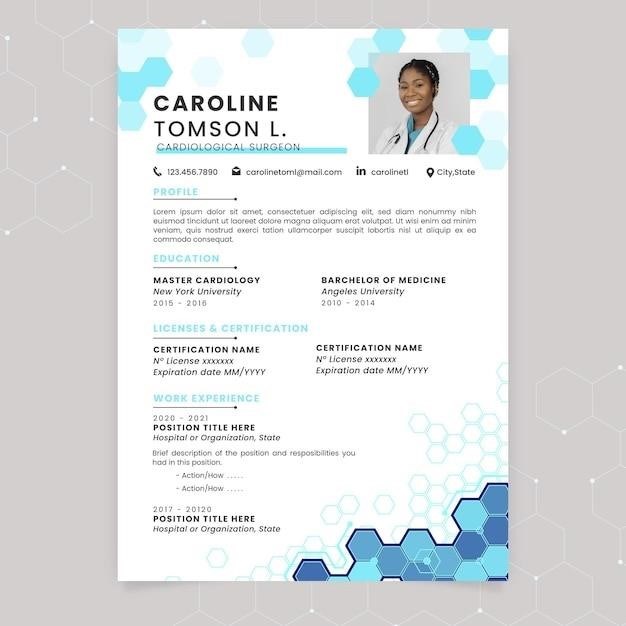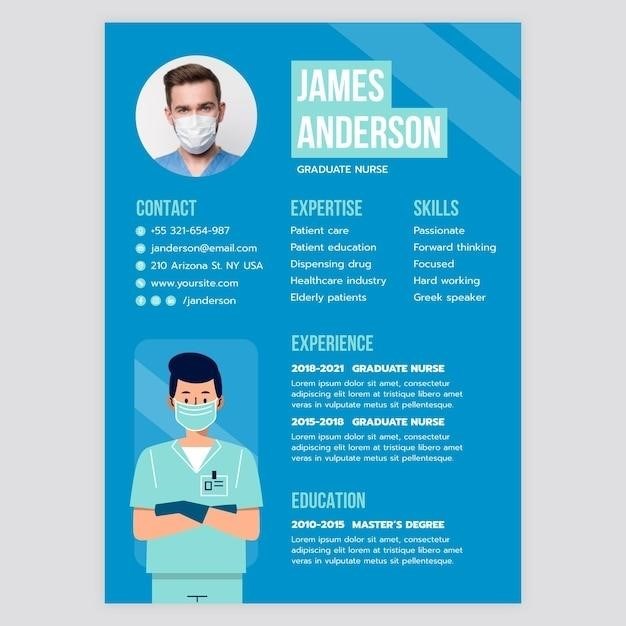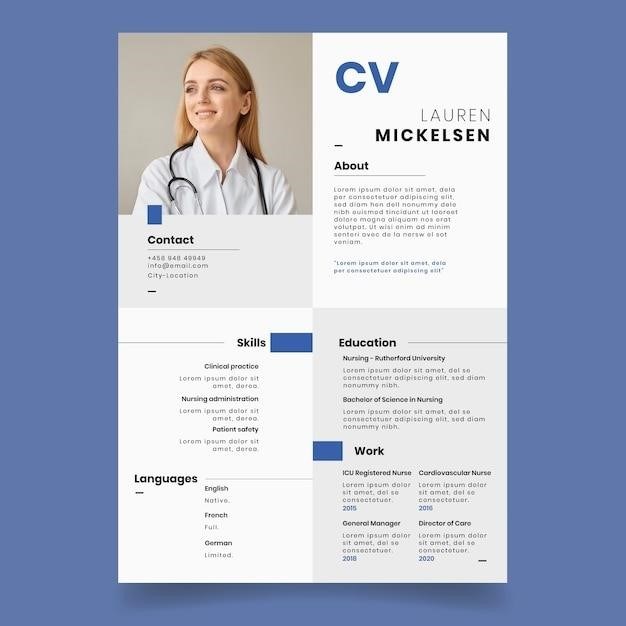Physician CV Sample PDF⁚ A Comprehensive Guide
This comprehensive guide provides a detailed explanation of how to create a compelling and effective physician CV, along with a sample template and valuable tips for success. Whether you’re a seasoned medical professional or a recent graduate, this guide will equip you with the necessary knowledge and resources to craft a CV that showcases your skills, experience, and qualifications to potential employers.
Introduction
In the competitive landscape of healthcare, a well-crafted curriculum vitae (CV) is essential for physicians seeking new opportunities. It serves as a comprehensive document that highlights your professional journey, showcasing your qualifications, experience, and accomplishments. A strong physician CV is not merely a list of credentials; it’s a strategic tool that tells your professional story and positions you as a valuable asset to potential employers. This guide will delve into the essential components of a physician CV, providing insights into formatting, content, and strategies for crafting a compelling document that stands out from the competition.
Importance of a Physician CV
Your CV is your first impression in the eyes of potential employers. It’s a vital tool for showcasing your expertise, achievements, and suitability for a particular position. A strong CV can make the difference between being overlooked and securing an interview. It serves as a detailed overview of your professional journey, allowing recruiters and hiring managers to quickly assess your qualifications and experience. In today’s competitive healthcare landscape, a well-structured and compelling CV is crucial for standing out from the crowd and making a lasting impression.

Key Components of a Physician CV
A physician’s CV should be structured to present a comprehensive picture of your professional journey. It should highlight your education, training, experience, and credentials in a clear and concise manner. Key components typically include contact information, education and training, professional experience, licenses and certifications, publications and research, honors and awards, and professional affiliations. Each section should be carefully crafted to demonstrate your expertise, commitment, and value to potential employers.
3.1. Contact Information
Your contact information should be prominently displayed at the top of your CV. Include your full name, professional email address, phone number, and professional website (if applicable). The information should be formatted in a clear and easy-to-read manner, ensuring that potential employers can easily contact you. Maintain a professional and updated email address and avoid using personal or informal email addresses.
3.2. Education and Training
This section should provide a detailed overview of your academic background and medical training. Begin with your highest degree, listing the name of the institution, the degree earned, the year of graduation, and any relevant honors or awards. Subsequently, list your medical residency and fellowship programs, including the name of the hospital or institution, the specialty, and the dates of training. If applicable, mention any additional certifications or special training you have received, such as board certifications or advanced training in specific procedures or areas of expertise.
3.3. Professional Experience
This section is crucial for showcasing your clinical experience and demonstrating your skills and expertise. Start with your most recent position and work backward chronologically. For each position, list the title, the name of the organization, the dates of employment, and a concise description of your responsibilities and accomplishments. Use action verbs to highlight your contributions, such as “provided comprehensive care,” “diagnosed and treated patients,” “conducted research,” or “presented at conferences.” Quantify your achievements whenever possible, using metrics like the number of patients treated, procedures performed, or publications authored.
3.4. Licenses and Certifications
This section is crucial for demonstrating your legal authority to practice medicine and your commitment to upholding professional standards. List all relevant licenses and certifications, including the issuing organization, license number, and expiration date. For example, you might include your medical license from your state, board certifications in your specialty, and any other relevant certifications, such as CPR or ACLS. If you hold licenses or certifications in multiple states or jurisdictions, list them all for clarity. This section is important for employers to verify your credentials and ensure that you are legally qualified to practice medicine in the desired location.
3.5. Publications and Research
This section highlights your scholarly contributions to the medical field. List any publications, research projects, presentations, or other scholarly activities. Include the title of the publication, the journal or conference where it was published, the year of publication, and your role in the project. If you have authored or co-authored any books, chapters, or articles, include those as well. For presentations, list the title, the conference, and the date. This section demonstrates your intellectual curiosity, commitment to knowledge, and ability to contribute to the advancement of medical knowledge.

3;6. Honors and Awards
This section showcases your achievements and recognition within the medical community. List any honors, awards, scholarships, or grants that you have received. Include the name of the award, the awarding organization, and the year you received it. For example, you might include “Dean’s List” or “National Merit Scholarship” for academic achievements, or “Outstanding Resident Award” for clinical excellence. This section demonstrates your dedication, hard work, and recognition by your peers and superiors.
3.7. Professional Affiliations
This section highlights your involvement in professional organizations related to your field. List any memberships, committees, or leadership roles you hold in organizations like the American Medical Association (AMA), specialty boards, or local medical societies. This section demonstrates your commitment to your profession, your network within the medical community, and your interest in staying abreast of current trends and advancements.
Formatting and Design Considerations
The visual presentation of your CV is crucial for making a positive first impression. Choose a clean and professional template with clear fonts, consistent spacing, and a logical layout. Use a standard font like Times New Roman or Arial in a size that is easy to read. Ensure your CV is free of grammatical errors and typos. Employ bullet points to list your achievements and experiences concisely. Keep the design simple and avoid excessive use of bolding or italics. Remember, your CV should showcase your expertise and professionalism, not distract from your credentials.
Sample Physician CV Template
A well-structured CV template can serve as a valuable starting point for crafting your own document. You can find numerous free physician CV templates online, including those offered by Resume Genius and Template.net. These templates provide a basic framework with sections for contact information, education, work experience, licenses and certifications, publications, honors and awards, and professional affiliations. Adapt the template to reflect your individual achievements and experiences, ensuring a clear and concise presentation of your qualifications.
Tips for Writing a Strong Physician CV
A strong physician CV goes beyond simply listing your credentials. It effectively communicates your value proposition to potential employers. Here are some tips to elevate your CV⁚
- Quantify achievements⁚ Instead of simply stating your responsibilities, use metrics to demonstrate your impact. For example, “Increased patient satisfaction scores by 15%” is more impactful than “Managed patient care.”
- Tailor your CV⁚ Customize your CV for each job application, highlighting skills and experiences relevant to the specific position.
- Proofread meticulously⁚ Errors in grammar and spelling can create a negative impression.
Conclusion
Crafting a compelling physician CV is crucial for standing out in a competitive job market. By following the guidelines outlined in this comprehensive guide, you can create a professional and impactful document that highlights your skills, experience, and qualifications. Remember to focus on clarity, conciseness, and quantifiable achievements. A well-structured and well-written CV is a valuable tool for securing your desired position in the medical field. By leveraging the resources and tips provided, you can confidently present your credentials and make a lasting impression on potential employers.
Resources for Further Information
For those seeking additional guidance and inspiration, numerous online resources offer valuable insights into crafting effective physician CVs. Websites like Resume Genius and Template.net provide sample templates and expert tips for tailoring your CV to specific specialties and career goals. Additionally, professional organizations such as the American Medical Association (AMA) and the Association of American Medical Colleges (AAMC) offer resources and career advice for physicians. These resources can help you navigate the intricacies of CV writing and ensure your document effectively showcases your qualifications and aspirations.
